Langkawi – Gunung Raya
Explore lah Life by Darren Ng on 29 September 2011
http://explorelah.blogspot.com/
Langkawi – Gunung Raya with Irshad Mobarak
I think what defines a good holiday is one that changes you. Be it from a highly stressed state to a reclamation of peace, physical burn-out to a sense of rejuvenation, from boredom to excitement, from ignorance to enlightened… Feeling refreshed and having loads of fun during a vacation is just fantastic. But they are only temporal escapes
In my opinion, a truly great and enduring holiday is one where we’ve also learnt something about the world we live in and come home with our horizons expanded. And a visit to Gunung Raya in the company of Langkawi’s celebrity naturalist, Irshad Mobarak, is one of those rare occsions where learning and fun intersects.
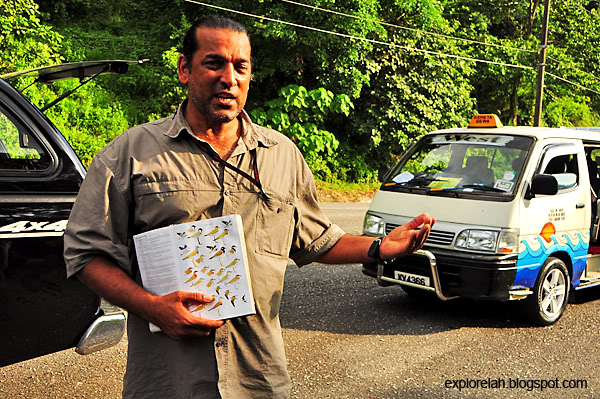 Animate, engaging and humourous, Irshad grips you with stories of the jungle and talks about every critter, bird, insect and plant like family. He towers over us with his large build, which is an apt size for his larger-than-life mission to protect Langkawi’s natural heritage.
Animate, engaging and humourous, Irshad grips you with stories of the jungle and talks about every critter, bird, insect and plant like family. He towers over us with his large build, which is an apt size for his larger-than-life mission to protect Langkawi’s natural heritage.
To me, Irshad represents somewhat of a modern day shaman as he embodies within him the spirit of the forest and the scientific knowledge about its inhabitants. He is a well-known and respected figure within the Langkawi tourism community and perhaps even the whole of Malaysia’s naturalistic associations for he’s the face of Tourism Malaysia’s docu-ad currently airing on Star TV
And might I add, he’s appeared in various documentaries by Nat Geo and Discovery Channel. We were so fortunate to have him personally take us on a field trip of the island’s wildlife!
Armed with books and a hands on approach, Irshad shared fascinating facts about birds such as the Red Wattled Lapwing, which will feign injury to lure predators away from its nest. He’s also really good at talking bird by imitating their calls with precision. His mimic of the Great Hornbill’s ‘orh-gok orh-gok’ call still rings in my ears. His knowledge of the forest extends to the plants where he could just pluck something from somewhere and start telling us about its pharmacological benefits
 Red Wattled Lapwing with a broken wing act. The bird lays its eggs on the ground and hence, highly susceptible to predation. To waylay predators, the lapwing will dive-attack hounds and other mammalian quadruped and if that failed to distract them from its nest, it will ‘fall down’ in front of them with a ‘broken wing’. It will then pretend to struggle and fly-fall to lead the animal away. But if the potential invader is a snake, which has poor eyesight, the bird will come right in front of it and perform the injured act. Irshad said : “This bird deserves an Emmy!” I think an Oscar too.
Red Wattled Lapwing with a broken wing act. The bird lays its eggs on the ground and hence, highly susceptible to predation. To waylay predators, the lapwing will dive-attack hounds and other mammalian quadruped and if that failed to distract them from its nest, it will ‘fall down’ in front of them with a ‘broken wing’. It will then pretend to struggle and fly-fall to lead the animal away. But if the potential invader is a snake, which has poor eyesight, the bird will come right in front of it and perform the injured act. Irshad said : “This bird deserves an Emmy!” I think an Oscar too.
Apart from a crash course on lapwings, eagles and the hornbill, we were also introduced to medicinal plants such as the Siam Weed. This crop and foliage poison is our medicine. The juice from its crushed leaves is found to contain anti-bacterial and anti-fungal properties and is effective in wound healing. In poorer nations, Siam Weed is purportedly used in the treatment of malaria and dysentery.
The plant can be found along our Singapore highways too! But don’t go harvesting it for use just yet as roadside foliage contain higher levels of metal contamination from vehicular fumes. There is a love-hate relationship with this plant… loved for its medicinal and nutritional applications but loathed for its obnoxious virility in growth.
While Irshad was giving us a lesson about birds and plants by the roadside, a zealously friendly calf made our encounter with nature all that more magical! It just loves being around people. I would’ve brought it home if I could! And not as veal.
Our winding drive up to the peak Gunung Raya was marked with many stops along the way when the trained eyes and ears of Irshad pick up trails of some exotic birds. In particular, we were hoping to see the Great Hornbill in its natural habitat. Here’s the lot of us tyring very hard to discern a horbill that Irshad had spotted from the dense green.
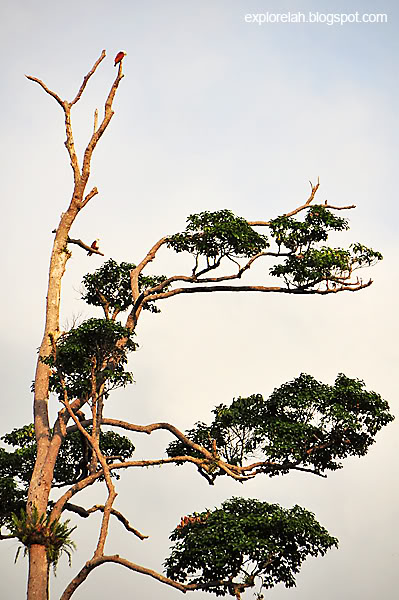 The hornbills eluded us but we saw a couple of Brahminy Eagles perched on a tree top. Yo eagle, how’s the view up there? :o) . My envy of the view the eagles had was quickly satiated with our arrival on the roof of Langkawi. Standing at 881m, Gunung Raya is the tallest mountain and offers a superb panoramic view of the island.
The hornbills eluded us but we saw a couple of Brahminy Eagles perched on a tree top. Yo eagle, how’s the view up there? :o) . My envy of the view the eagles had was quickly satiated with our arrival on the roof of Langkawi. Standing at 881m, Gunung Raya is the tallest mountain and offers a superb panoramic view of the island.
Unfortunately, our visit met with thick fog and we could hardly see much. But the cooler temperature was a welcome from the tropical heat. I estimate that the drive up should take no more than 45 minutes without stops. As we made our way down Gunung Raya at dusk, sleep taking over us due to a day packed full of programmes, we suddenly came to a stop. Still rather drowsy, my senses immediately fired up when I was told that Great Hornbills have been sighted!
Can’t really see them clearly but Irshad made up for it with a very touching story. The hornbills mate for life and form lifelong bonds and there was a pair that Irshad had gotten to know. One day, a gunshot rang through the forest and the female collapsed to the ground. A man in a motorcycle sped away with it.
For the next one and a half year, the remaining male hornbill would fly to the very branch on which its mate was killed and called out to it. The male hornbill had since found a new mate but occasionally, it can still be seen at that tree spot. So, do you want your relationship to be a hornbill, or chicken?
 Hunt for the Controversial Colugo
Hunt for the Controversial Colugo
After Gunung Raya, Irshad took us on a night excursion of the forest. So exciting! I’ve never explored the forest at night before. Our main purpose here was to look for the elusive Colugo who, get this, is our genetic relative!
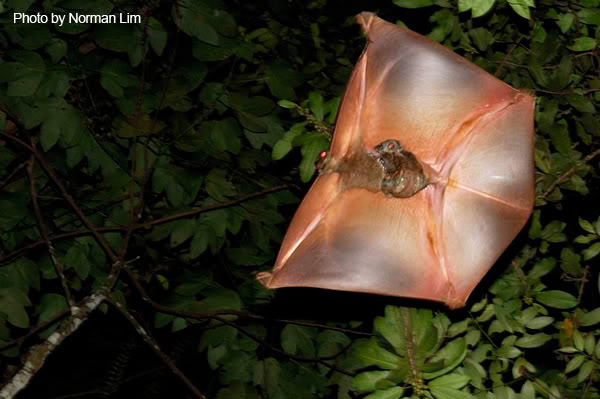 Strong torchlight is a must for a night survey of the trees. I brought along a LED torchlight which looked very bright to me but was totally weak when shining up at the trees. The darkness hardly barged.
Strong torchlight is a must for a night survey of the trees. I brought along a LED torchlight which looked very bright to me but was totally weak when shining up at the trees. The darkness hardly barged.
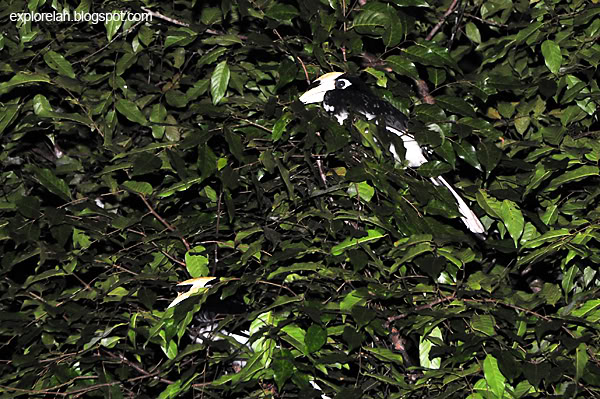 Saw a pair of resting Oriental Pied Hornbills at pretty close range. Awesome!. Our night reverie was accompanied by cricket mating calls. Here, a female cricket was on its way to meet a date. The orangey spot was cast by a tungsten torch.
Saw a pair of resting Oriental Pied Hornbills at pretty close range. Awesome!. Our night reverie was accompanied by cricket mating calls. Here, a female cricket was on its way to meet a date. The orangey spot was cast by a tungsten torch.
Did you spend a lot of time with the photo preceding the above one looking for what’s hidden in the branches? You’ve been had. Haha. There’s nothing in the photo except the foliage. I’m just kidding with you but also to show you how hard it was to spot anything on the leafy ceiling.
We shone our torchlights into the trees hoping to catch an eye shine (tapetum lucidum effect) which will indicate a Colugo (pray it’s not Potianak!) but to my unaccustomed eye, I saw nothing. But on the ground, I caught sight of a huge cricket, I mean a really BIG one hurrying across the forest floor. And Irshad promptly picked it up told us their story…
There are two types of male crickets – the noisy ones and quiet ones. A quiet cricket? Now, that’s something new.The noisy crickets get more girlfriends but lead very short lives as they attract predators and a parasitic fly that lays eggs into their bodies. When the eggs hatch, they burst from the cricket’s abdomen Alien-style.
The quiet ones would hang around the noisy ones and wait. When the loudmouths get busy with a mate, they stop cricketing but their calls would’ve attracted other females to come their way. At this point, the quiet ones let out a small whimper. Thinking that its the male they were after, the females mate with the cheaters.
The quiet male cricket may not get an orgy, but it gets to live very long. So what do we learn from the male crickets? Promiscuity kills ya faster!
Letting the female cricket continue its way to heed the mating calls, Irshad plucked some leaves from the ground and introduced us to the Indian Pennywort. The leaves can be eaten raw in a salad or dried and consumed as tea.
From his glowing account of the medicinal benefits of this herb, I wanted to just get down on all fours and start munching on them! The plant has a long history as a traditional medicine in the Chinese, Indonesian, Vietnamese, Thai and Ayurvedic systems of healing which modern science is beginning to verify. A drug for cardiovascular diseases made from the active constituents of the Indian Pennywort may soon find its way into our Western pharmacies soon.
According to clinical studies, the herb is a mild adaptogen which has the ability to regulate stress and act as a sort of tonic for general health like ginseng, has anti-microbial efficacies, possesses anxiolytic properties (mild tranquilising effects helpful in combating anxiety disorders), and also an aphrodisiac! Plus it can stimulate collagen production so it is a great ally for age-defying skin. That’s a green fountain of youth right beneath my feet!
|
Image of Colugo with young clinging to its body taken from Penn State Eberly College of Science archive. Gestation takes 60 days and the infants live with the parent for about six months. |
Our search for the Malayan Colugo (a.k.a. Sunda Flying Lemur) was futile. Irshad told us it’s unusual not to catch them in action. Guess our lucky stars had fallen asleep that night. But I’ve found a photo to show you because this animal is pretty amazing.
Nicknamed the Flying Lemur of Southeast Asia, the misnomer is far-fetched because the Colugo neither flies (it glides) nor is it a lemur. When it was first discovered, the nocturnal creature was classified under the order of the primates. Humans are in the primate order. But it was later classified under the order of the bats because it has skin for wings. Colugos are not flying squrriels or flying foxes.
But later DNA mapping found that it is closer to the primate genome. In other words, we humans are relatives with the Colugo! This animal has been classified into a new order own its own (Dermoptera) with two species – the Sunda Colugo and the Philippine Colugo. They can be found in Singapore too at Bukit Timah Nature Reserve, MacRitchie Reservoir and I believe other forested areas of our tiny red dot.
While I was disappointed at not having the opportunity to catch the Colugo with my own eyes, my eyes have been opened to a lot more about the romance, survival tactics and healing powers of nature. For a truly rewarding experience of Langkawi’s wildlife, you can book tours with Jungle Walla where Irshad is the resident naturalist. It’s totally worth it.
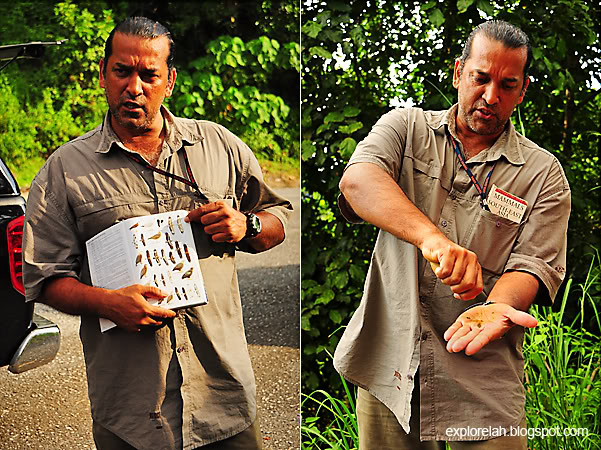
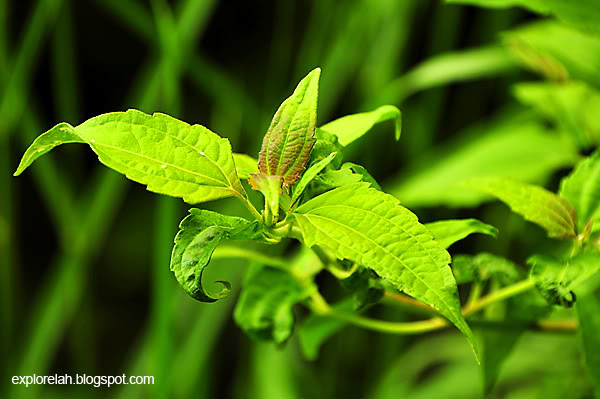


 Previous Post
Previous Post Next Post
Next Post







